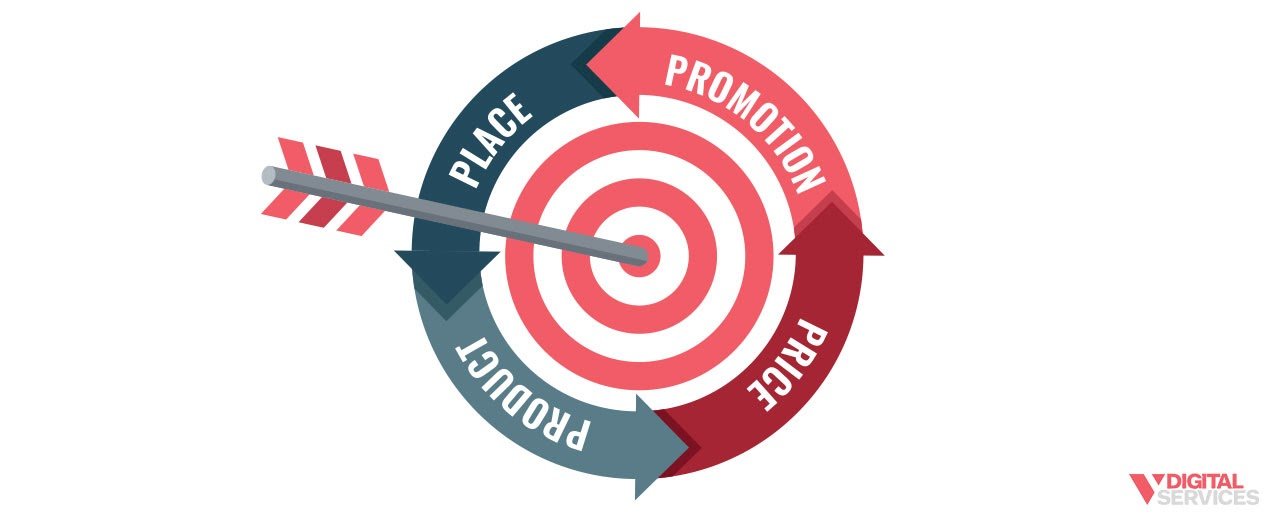No matter how unique your business may be, it can sometimes feel as if you have countless competitors with concepts nearly identical to yours. And depending on your industry, you might very well be dealing with some serious oversaturation.
Luckily, you can set yourself apart with the right strategy and create a niche where your business can truly shine. Even if your competitors bring talent, quality, and great service to the table, the not-so-secret way to stand out in all the right ways is marketing positioning.
When it comes to branding and positioning a business in the market, the V Digital Services team is a fearsome opponent. We know what it takes to help a brand claim its rightful spot in its industry, including how to develop and implement a strong positioning strategy. And better yet, we’re here to share what we think you absolutely must know about your positioning in marketing right now.
In this guide to how to set up a strategy for marketing positioning, we’ll be giving you a rundown of:
- What positioning in marketing is and what purpose it serves
- Different types of marketing positioning strategies
- Tips for creating your own strategy for market positioning
By the time you’re done reading, you’ll be prepared to start thinking about how to better position your brand for marketing success.
What is Market Positioning?
The process of market positioning focuses on establishing a clear brand image or identity, ensuring that its target audience perceives the brand in a certain way. More specifically, the goal is to influence the customer perception of a brand in relation to its competitors.
For example, a certain designer brand may use marketing positioning to establish its products as status symbols of luxury. Or, a family-friendly fast food restaurant chain might position itself as a provider of healthy, inexpensive meals that both kids and adults enjoy.
Types of Strategies for Positioning in Marketing
There are many ways to approach positioning in marketing. The more specific and detailed your strategy for market positioning, the more effective it’s likely to be.
You may commonly see marketing positioning strategies referred to as the “Four P’s”:
- Promotion
- Price
- Place
- Product
 However, there are many different schools of thought on this topic, so the possibilities are virtually endless. Here are some examples of strategy types and what they’re used for:
However, there are many different schools of thought on this topic, so the possibilities are virtually endless. Here are some examples of strategy types and what they’re used for:
- Product price: Customers associate your brand, products, and/or services with competitive pricing
- Product benefits and/or attributes: Customers perceive your brand, services, and/or products as having specific beneficial value(s) or characteristics
- Product quality: Customers associate your brand, products, and/or services with high quality and excellent levels of satisfaction
- Product application and use: Customers connect your brand, products, and/or services with a certain use
- Competitors: Customers perceive your brand as superior to your competitors
Once those strategies are put into action, the results might look something like this:
Let’s say that you own a coffee shop in your community, and you’re working to more effectively position your brand in the market. Your main competition is the nearby location of a fast-food restaurant, which offers cheap coffee as a part of their morning meal deals.
So, you might launch a short video for social media advertising that establishes your brand as one that uses only 100% organic coffee, offers a diverse selection of standard and alternative milk options, and boasts beverages with smooth, rich flavors. Your strategy hones in on the quality of your products, as well as the benefits of choosing your brand over your fast food competitor. As a result, your target audience recognizes you as unique from the competition in several important ways.
The next time they want a delicious, high-quality cup of organic coffee, they go to your coffee shop. And that’s the impact of marketing positioning.
What About Marketing Repositioning – What Does That Mean?
There are certain situations in which a brand or company decides that it’s time to change its product status or redefine its brand in the marketplace. This is called market repositioning.
Generally, there are many different reasons for a strategy for repositioning in marketing. The most common factors are significant shifts in the marketplace/environment or a serious decline in performance.
Since a full-scale repositioning effort can be expensive and time-consuming, some companies instead decide to launch an entirely new brand or a new product/service.
How to Create an Effective Marketing Positioning Strategy
Developing a strategy for marketing positioning can become extremely complicated, making it a task best navigated with the help of an experienced team. If your brand can benefit from market positioning, we encourage you to connect with our digital advertising agency to get the support you need.
Even so, understanding the basic steps to positioning in marketing is very useful – whether or not you’re ready to implement them yourself. Here are our top marketing positioning tips for setting you up with a good framework for thinking about what you can do to define your brand in your industry.
1. Create a clear positioning statement to guide your efforts.
Think of your positioning statement as a marketing mission statement of sorts, outlining the identity your brand is striving to create. Your positioning statement pinpoints a) who you are and b) what your brand stands for, then describes the c) target audience of your brand, d) their problems/pain points, and e) how your business solves their issues.
 You’ll need a good foundation of branding basics to design your positioning statement, including:
You’ll need a good foundation of branding basics to design your positioning statement, including:
- A target audience
- Your target market
- A value proposition statement
- Content that will prove your value
In just a couple of sentences, your positioning statement summarizes the guiding principles behind your biggest marketing decisions – specifically, the choices that impact the way potential customers perceive your brand.
Here’s an example of a positioning statement: Jackson’s Convenience Store is a friendly neighborhood retailer that provides everyday necessities for customers who want quality service, convenient access to products, and excellent prices. We’ve assembled a selection of the most in-demand items in one easy-to-shop space, saving our customers time, hassle, and money – so they can skip the big box stores and focus on getting back to their busy lives.
Struggling to write a positioning statement for your brand? Here are some key questions to ask yourself to get your wheels turning:
- Who are my target customers, and what are their needs?
- How am I different from my competitors?
- What can I offer customers that nobody else can?
- What are the core characteristics of my brand?
2. Translate your positioning statement into a concise but powerful tagline.
Now that you have a positioning statement, you can turn it into your tagline (also known as a slogan). Most positioning statements are too long for customer messaging, but your tagline is a snappier version that still gets the same ideas across.
Using the convenience store example we stated above, here’s one idea for a tagline: Get the low-priced, brand-name basics you need to get on with your day at Jackson’s Convenience Store.
3. Check out the competition.
Competitor analysis is one of the best moves you can make to grow and improve your business. Not only does it give you a better picture of what your competition is bringing to the market – and how they’re advertising it – but you can also gain an understanding of your own strengths and weaknesses. As a result, you’ll be far better prepared to successfully carve out your niche.
 You want to be on the lookout for gaps in the market that your business can fill. So, be sure to closely consider:
You want to be on the lookout for gaps in the market that your business can fill. So, be sure to closely consider:
- Competitors’ past marketing efforts, messaging, engagement with customers, messaging, and alignment with market trends
- Competitor strategies, including advertisements, white papers, and promotional campaigns
- The target audiences of your competitors, including how they overlap with the customers you want to reach
- Your competitors’ market share, growth rate, and other relevant data
The goal here is not to figure out how to copy your competitors. Rather, this will enable you to blaze your own trail and find your “sweet spot” for marketing positioning.
4. Figure out where you currently stand.
Once you know where your competitors are at (and what they did to get there), it’s time to take a closer look at your own business. Using a similar lens to the one you applied when considering the competition, understand where your brand stands now. Once you know your starting point, you can make plans to improve and grow.
5. Develop, launch, test, and refine your marketing positioning strategies.
Now, you’re ready for takeoff! Or, more specifically, to kick off a positioning strategy.
 With all of the information you gleaned in the first four stages, you should have the raw materials needed for a well-rounded strategy for positioning. Of course, this is where working with a marketing team comes in especially handy – so if you haven’t yet, this might be the time to reach out.
With all of the information you gleaned in the first four stages, you should have the raw materials needed for a well-rounded strategy for positioning. Of course, this is where working with a marketing team comes in especially handy – so if you haven’t yet, this might be the time to reach out.
At V Digital Services, we aren’t proponents of a “one and done” marketing approach. So, our work continues long after your strategy has been implemented. We consistently utilize advanced analytics and data gathering to measure the effectiveness of our efforts. Not only does this illuminate a clear path towards constant improvement, but it also helps you stay on top of what’s happening with your brand and how your marketing dollars are being spent.
Put Your Business in a Position to Win When You Partner with VDS
 As a business owner, you have a lot on your plate – and standing out from the competition is just of the many critical things vying for your attention. You’re the expert in your goals and business, and we’re the experts in branding, digital marketing, and smart strategy. Together, we can leverage the power of marketing positioning to help your business gain customers and build long-term success.
As a business owner, you have a lot on your plate – and standing out from the competition is just of the many critical things vying for your attention. You’re the expert in your goals and business, and we’re the experts in branding, digital marketing, and smart strategy. Together, we can leverage the power of marketing positioning to help your business gain customers and build long-term success.
No matter how broad or narrow your niche, V Digital Services is prepared to help the right customers find you at the right time. We go beyond the typical marketing plan to deliver a tailored service experience, aligning our efforts with your unique needs and goals. The result is a collaborative partnership that spurs measurable growth for your brand.
Take a proactive role in defining how customers perceive your brand by using positioning in marketing to your advantage. Find out how to get started when you contact V Digital Services today!
Featured Images: oumjeab/Shutterstock


 PREVIOUS
PREVIOUS